Samsung QN900D review: the best 8K TV yet… and one of the best TVs of any kind
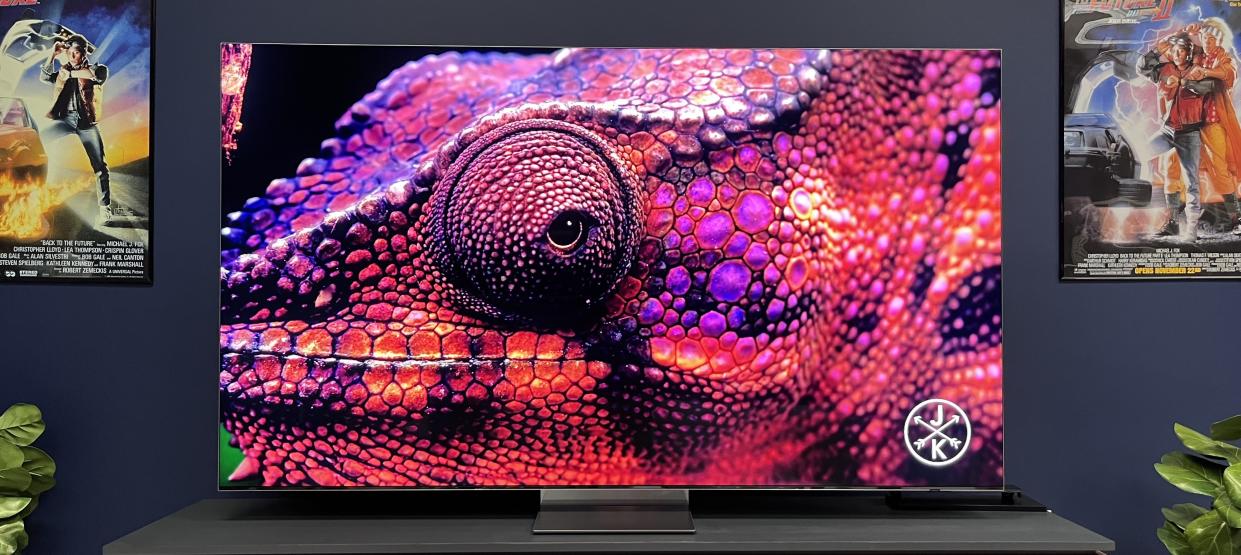
Samsung QN900D: Two-minute review
The Samsung QN900D is the company’s flagship 8K TV for 2024, and it improves on the Samsung QN900C – 2023's best 8K TV – in key areas. Importantly, these improvements don’t come with a cost increase over last year’s flagship, though the 75-inch model I was sent for my Samsung QN900D review is still a very pricey and premium TV at $6,299 / £6,499 / AU$8,999.
Samsung makes some of the best TVs and is a steadfast flag-bearer for 8K. The Samsung QN900D backs that stance up by providing not just 8K support but high-quality upconversion of 4K and lower-resolution programs. It features Samsung’s new NQ8 AI Gen3 Processor, which has eight-times as many AI-smartening neural networks as the one found in the QN900C, and brings AI powers to not just upconversion, but image depth and motion enhancement.
When I tested the QN900C in 2023, I walked away a bit disappointed with the local dimming performance of its mini-LED backlight. There's no such issue with the Samsung QN900D, which suffers from very few instances of backlight “blooming” while delivering high peak brightness levels with HDR movies and shows. Ultimately, the QN900D’s tremendous picture detail grabs you, with fine textures in both 4K and 8K images looking crisp yet fully natural.
The QN900C’s Infinity Air Design combines a near-invisible bezel with a mirrored pedestal stand to give the TV an elegant “floating” look. Its external One Connect Box eases connections for wall mounting, and has a new more compact design. A built in 6.2.4-channel Dolby Atmos speaker system delivers reasonably potent audio for a slim TV, and it also features Samsung’s Object Tracking Sound Pro and Q Symphony features to enhance the sound presentation.
Samsung’s Tizen smart TV system on the QN900D has received several tweaks for 2024, with new features such as customized recommendations, which now include games as well as movies and TV shows. Gaming performance on the TV is outstanding, with an ultra-low 10.8ms input lag and support for up to 4K 240Hz – a feature unique to the QN900D – on all four of the TV’s HDMI 2.1 ports, plus VRR with FreeSync Premium Pro support. Samsung Gaming Hub, meanwhile provides a one-stop shop for cloud-based games from Xbox, Nvidia GeForce Now, Utomik, and more, and it also shows connected gaming consoles for easy access.
The Samsung QN900D’s price tag undoubtedly puts it out of reach for many, and a good argument can be made that the company’s same-size 4K TVs such as the Samsung QN90D mini-LED and Samsung S95D OLED models can provide an equally good experience at a much lower price. But if you’re intrigued by the picture quality benefits that the QN900D’s 8K upconversion of 4K or even lower-resolution sources brings, or simply want that 4K 240Hz support for PC gaming, the QN900D won’t disappoint.
Samsung QN900D review: price and release date
Release date: March 21, 2024
65-inch: $4,999 / £4,999 / AU$6,499
75-inch: $6,299 / £6,499 / AU$8,999
85-inch: $7,999 / £9,499 / AU$11,999
The Samsung QN900D was released in late March 2024 and is available in 65-, 75-, and 85-inch screen sizes. Samsung also retains a 98-inch 8K TV in its lineup, the Samsung QN990C, a $40,000 model released in late 2023 that carries over.
The launch prices for the Samsung QN900D series are the same as for last year’s Samsung QN900C in all screen sizes. Samsung doesn’t have much competition when it comes to new 8K TVs, making it difficult to put its pricing in perspective. The QN900C saw discounts fairly quickly, however, with the 75-inch version – the same size as tested here – eventually dropping to $4,799 in the US.
Samsung QN900D review: specs
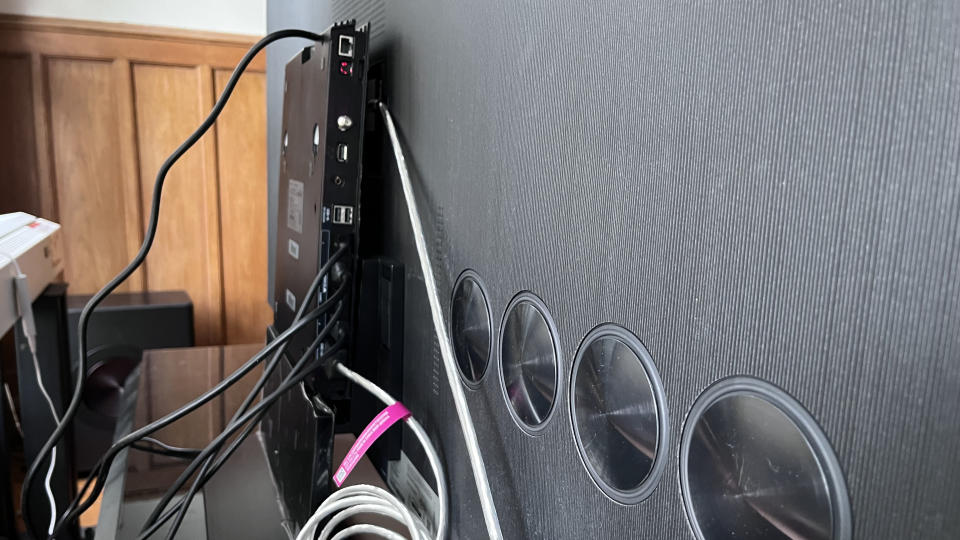
Samsung QN900D review: features
8K resolution with AI upscaling
One Connect Box with four HDMI 2.1 ports
6.2.4-channel Dolby Atmos speaker system
The Samsung QN900D series received a processor refresh for 2024. The new NQ8 AI Gen3 Processor features 512 neural networks – eight times as many as last year’s model, according to Samsung – and it brings powerful AI capabilities to the new TVs. A key one is Quantum Super Resolution Pro AI upscaling, which is used to fill the 33 million-plus pixels – four times as many as in a 4K TV – in the QN900D’s 8K display when viewing lower-resolution movies and TV shows. Of course, the QN900D can also display actual 8K video, although such content is mostly limited to YouTube streams at present.
Two additional AI-driven picture-enhancing features on the QN900D are Real Depth Enhancer Pro and AI Motion Enhancer Pro. In Samsung’s words, AI Motion Enhancer Pro "maximizes mini-LED control to enhance contrast even in fast-moving scenes," while AI Motion Enhancer Pro, an exclusive QN900D feature, optimizes sports viewing via a ball-tracking algorithm that uses picture information from an onboard database to fill in any visual gaps of a ball in motion frame-by-frame.
Connections to the TV are made using Samsung’s external One Connect Box, which now has a more compact design that makes it easier to conceal. This features an ATSC 3.0 next-gen TV tuner and four HDMI 2.1 ports with support for up to 4K 240Hz VRR for gaming – a first on a consumer TV. As with other Samsung TVs, the QN900D has Samsung Gaming Hub for playing cloud-based games from Xbox, Nvidia GeForce Now, Amazon Luna, and other services, and there’s also a Samsung TV Plus portal that lets you watch more than 250 live TV channels and thousands of movies and TV shows on demand for free.
The QN900D has a built-in 6.2.4-channel Dolby Atmos speaker system powered by 90 watts. Object Tracking Sound Pro links sound effects and dialogue to the onscreen action and there’s also Samsung’s Q Symphony feature that combines the output of the TV's speakers with a compatible Samsung soundbar for an enhanced audio presentation.
The only major feature that isn't supported here is Dolby Vision. But given that Dolby Vision makes the biggest difference for lower-brightness TVs, it's not too much of a miss here, because this set is plenty bright.
Features Score: 5/5
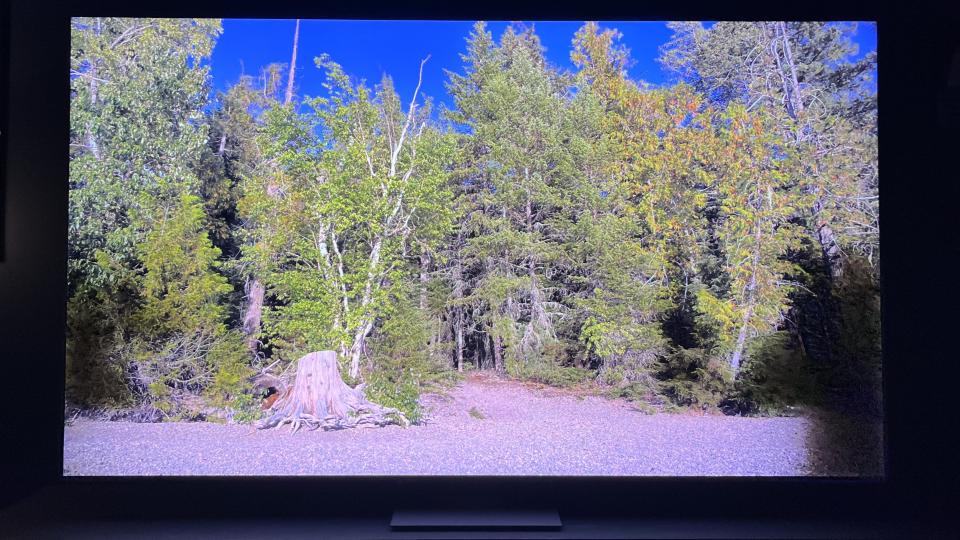
Samsung QN900D review: picture quality
Excellent brightness
Fine local dimming
Detailed, natural-looking 8K upconversion
The picture quality on the QN900D is, simply, best-in-class. Not just for 8K TVs, but for mini-LED TVs more generally, delivering stunningly bright and real HDR with deep and convincing black tones, and very strong light control for impressive contrast – and all backed up by incredible texture and detail.
Let's talk numbers. The 77-inch Samsung QN900D’s peak brightness measured on a 10% window in Filmmaker Mode was 1,870 nits. Full-screen brightness was also impressive, with Samsung’s 8K TV measuring 470 nits in the same mode on a 100% white pattern. The QN900D also had great brightness results in its Standard mode with a non-HDR source, measuring 1,256 nits and 570 nits respectively on a 10% and 100% pattern.
UHDA-P3 color space coverage on the QN900D in Filmmaker Mode was 95%, and its BT.2020 coverage was 71%. Grayscale and color accuracy as determined by averaged Delta-E values (see how we test TVs for details) were 5 and 2.5, respectively. We typically look for values below 3, so while colors are great, gray tone accuracy was a little imperfect out of the box. The QN900D’s plentiful advanced picture settings, including a 20-point white balance adjustment, allowed me to calibrate the grayscale, however, yielding a superb post-adjustment Delta-E of 1.6.
Watching demo footage from the Spears & Munsil Ultra HD Benchmark 4K Blu-ray test disc, I was struck by the level of detail, in particular a shot of spindly trees on a rocky beach. The Samsung QN900D conveyed the fine branches and other textures in a natural manner, with no sign of artificial-looking enhancement related to its 8K upconversion.
Other shots from the test disc revealed excellent local dimming control, with the edges between bright objects and black backgrounds showing only the slightest level of backlight “blooming” effects. The QN900D even aced a tough Starfield test pattern consisting of nothing beyond clustered pinpoints of light floating against a black field. Although I did see some instances of blooming with the TV’s Local Dimming adjustment set to High, blacks remained deep for the most part, while the “stars” retained brightness.
Turning to other tried-and-true reference 4K discs and scenes, motion handling proved very good when I watched a scene from the James Bond film No Time to Die where Bond walks across a craggy hillside cemetery. And in an early scene from Dune where Paul Atreides and his mother, Lady Jessica, walk in a gloomy space followed by orbs of light, the TV’s clean processing ensured that the picture was noise-free, while its powerful contrast brought out the highlight detail in the floating light orbs.
Streamed programs also looked excellent on the Samsung QN900D. Watching Episode 8 of Shōgun on Max, the intricate patterns in the characters’ historical costumes could be clearly seen, and the set’s high detail level also revealed some computer-generated imagery, especially in the historical drama’s wide shots of cities and landscapes. Turning to 8K programs available on YouTube, nature docs mainly, aerial shots of jungles and close up shots of lizards also looked incredibly detailed and had rich color, making me want to put my face up close to the screen to fully observe the textures.
As impressive as real 8K images looked on the Samsung QN900D, it was the AI Motion Enhancer Pro feature that really grabbed my attention. I watched several soccer, basketball, and hockey games, and in each case, the ball (or puck) looked clear and solid throughout, even when traveling at a rapid speed. AI Motion Enhancer Pro uses a ball-tracking algorithm and an onboard picture database to fill in any visual gaps of a ball in motion. And while I couldn’t shake the thought that the soccer ball my eyes were following wasn’t a real ball but an AI-created one, it nonetheless looked perfectly authentic.
Is everything perfect with the Samsung QN900D’s picture? Some screen glare was visible when overhead lights were turned on, and picture contrast and colors faded to a degree when I viewed at an off-center seat. But aside from those relatively small issues, all was smooth sailing.
Picture quality score: 5/5
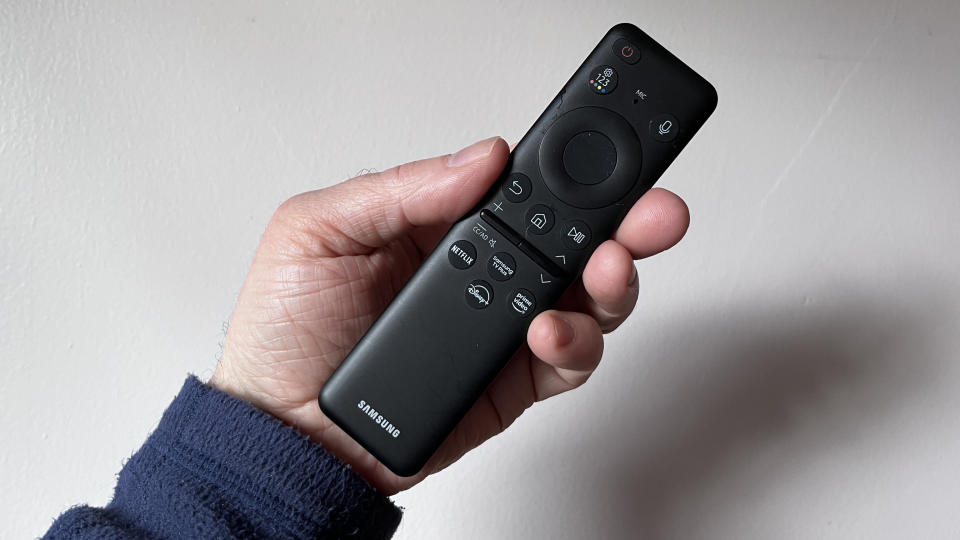
Samsung QN900D review: sound quality
6.2.4-channel Dolby Atmos speaker system
Somewhat lean bass
Bluetooth input and output
Sound on the Samsung QN900D is provided by a 6.2.4-channel speaker system powered by 90 watts. This provides a good sense of spaciousness when watching movies and shows with Dolby Atmos soundtracks. Dialogue is also clear and can be further enhanced by selecting the Amplify sound mode (the only other available mode is Standard). I found it was pretty easy to max out the volume level when watching movies on the QN900D, however, and the bass was somewhat lean, though that’s a typical shortcoming with slim TVs.
Audio features include Object Tracking Sound Pro, which helps to link sound effects to the action happening onscreen for a more natural presentation, and Q Symphony. This feature combines the TV’s built-in speakers with those of a compatible Samsung soundbar system like the Samsung HW-Q990D, for an even bigger soundscape. There’s also Bluetooth input and output, with the latter used to link wireless headphones with the TV for private listening.
Sound quality score: 4/5

Samsung QN900D review: design
Infinity Air Design with floating stand
External One Connect Box used for connections
SolarCell remote control doesn’t require batteries
The QN900D has what Samsung calls an 'Infinity Air Design'. This involves a near-invisible bezel that gives the TV an 'all-picture' look. Another part is a pedestal stand with a mirror surface that makes the screen look as if it’s floating. A new, more compact version of Samsung’s One Connect Box is used for connecting external sources, and it can be easily stashed behind the stand for a clean installation when the TV isn’t wall-mounted.
Samsung’s SolarCell remote control is included with the QN900D. Unlike most other “eco-friendly” efforts made by TV manufacturers, the SolarCell remote, which draws power from available room light and your home’s wireless network, makes a substantial eco-impact by eliminating the need for disposable batteries. Otherwise, it’s a basic, compact remote control that's mainly used for navigating the TV’s Tizen smart interface and onscreen menus and has buttons to access the best streaming services like Netflix and Disney Plus.
Design score: 5/5
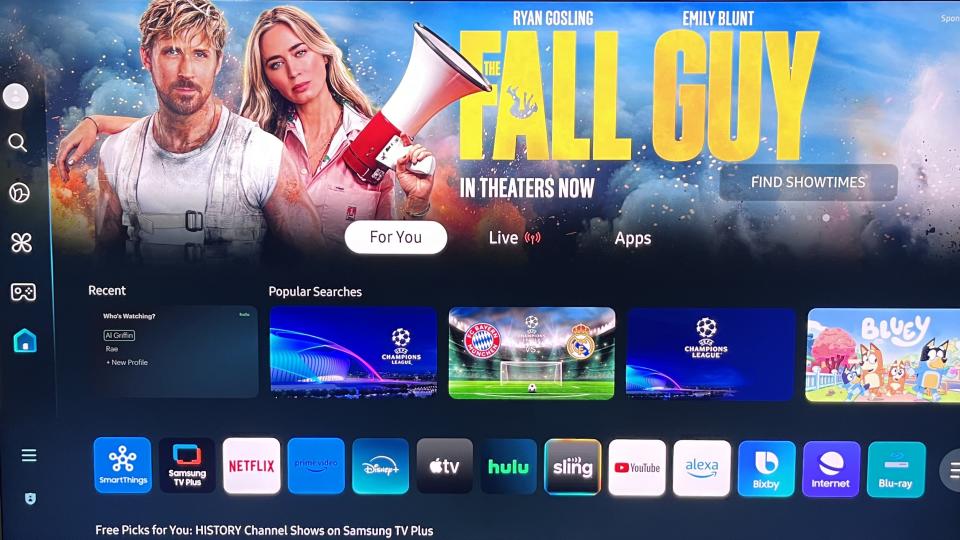
Samsung QN900D review: smart TV & menus
Revamped Tizen smart TV interface
Live TV, Gaming, Ambient, and Daily+ hubs
Extensive Expert settings
Samsung’s Tizen smart TV interface received a few tweaks for 2024. Mainly, recommended content on the home screen is personalized based on your watch history and now includes game selections from Samsung Gaming Hub. Most recommendations are on secondary screens that you scroll down to access. Otherwise, the main home screen features a Recent window that lets you easily return to whatever streamed program or external source you were last watching, along with windows for popular searches and a row of apps at the bottom that can be customized based on your most-used apps.
Other “portals” that can be accessed from the Tizen smart interface include Live TV (free live TV channels and on-demand programs on Samsung TV Plus); Samsung Gaming Hub; Ambient, which offers a wide range of artwork selections to display plus 'Routines' to change up content on a timed schedule; and Daily+, which serves as home base for Samsung SmartThings and Samsung Health apps, along with Workspace PC connection and Philips Hue lighting control apps.
Samsung’s Settings menu provides an easily accessible horizontal row of picture and audio-related settings, with the option to customize the order of items appearing in the list. The Expert settings sub-menu offers a plethora of picture adjustments, including Picture Clarity with custom Blur and Judder settings for motion handling, and Auto HDR Remastering to convert standard dynamic range pictures to high dynamic range.
Smart TV & menus score: 4.5/5
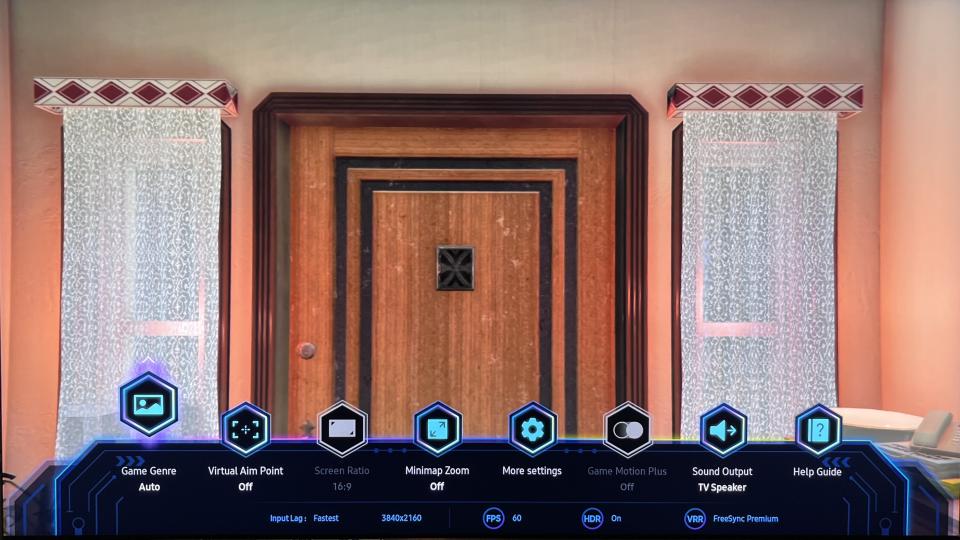
Samsung QN900D review: gaming
Four HDMI 2.1 inputs with up to 4K 240Hz support
Samsung Gaming Hub cloud-based gaming
Low 10.8ms input lag
Samsung’s 8K TV has all the gaming features found on its 4K models, plus a new feature exclusive to the QN900D: 4K 240Hz support. Samsung Gaming Hub offers a central spot to access cloud-based games from Xbox, Nvidia GeForce Now, Utomik, Luna, Boosteroid, and more, and it also automatically shows connected consoles – an Xbox Series X in my case – for quick access. The Gaming Hub layout can be customized, and when you call up the Game Bar on-screen menu, the settings include an AI Auto Mode that can adjust picture and sound settings based on the game genre.
The Xbox games I played had fluid action and looked great upscaled to 8K on the Samsung QN900D’s screen. Along with up to 4K 240Hz support on all four HDMI 2.1 inputs, the set has VRR with FreeSync Premium Pro support, and when in Game Mode its input lag measured with a Bodnar 4K HDMI input lag tester was 10.8ms – an excellent result.
Gaming score: 5/5
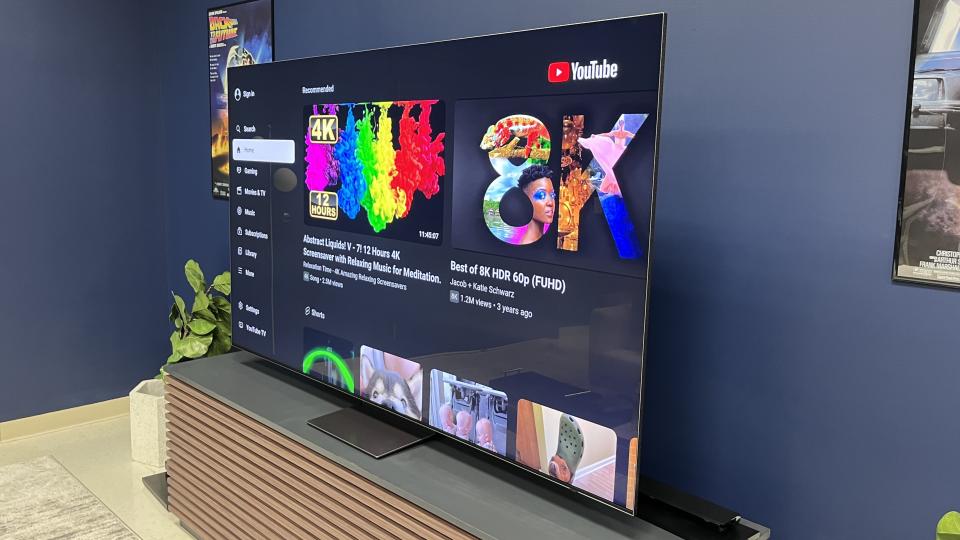
Samsung QN900D review: value
Expensive
Can buy premium 4K TVs for half the price
Offers unique features not found in other TVs
At $6,299 / £6,499 / AU$8,999, the 75-inch Samsung QN900D I tested is about as pricey as a TV at that screen size gets. For comparison’s sake, you can buy a 75-inch Samsung QN90D, the company’s new flagship 4K mini-LED TV in the US, for around half the price, and having conducted a hands-on review of that model, I can say that you’d be very happy with its performance. A Samsung S95D QD-OLED TV in a 77-inch screen size is also $4,599 in the US, which is a significant price difference.
Essentially, what you’re paying for with the Samsung QN900D is 8K support, plus AI-driven processing magic that can make 4K and lower-resolution programs look like they were shot in 8K. Otherwise, the QN900D uniquely offers 4K 240Hz support for gaming, and its picture quality, design, and feature set are everything you’d expect from an expensive high-end TV.
Value score: 3.5/5

Should I buy the Samsung QN900D 8K TV?
Buy it if...
Don't buy it if…
Also consider...
How I tested the Samsung QN900D 8K TV
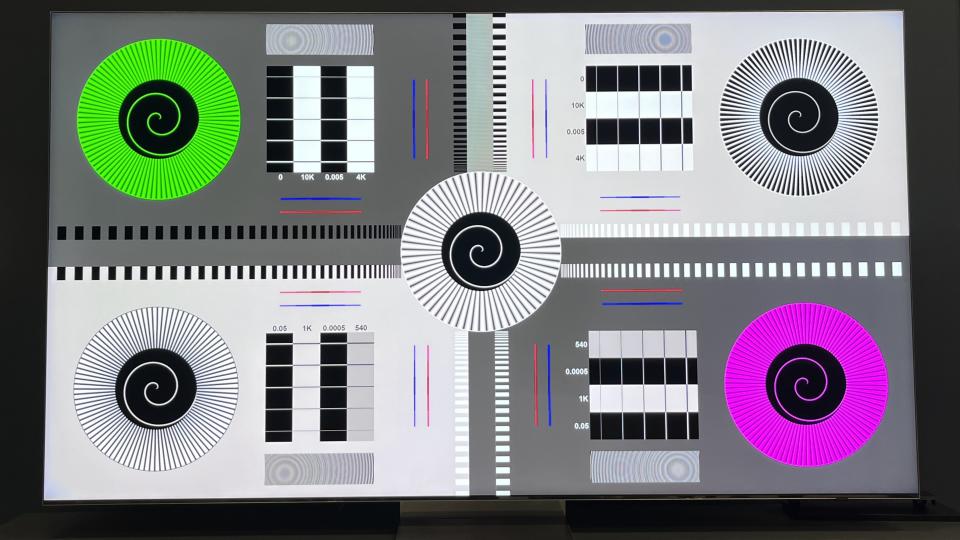
Tested over the course of two weeks
Measurements were made using Calman color calibration software
A full calibration was made before proceeding with subjective tests
When I test a TV, I first spend a few days or even weeks using it for casual viewing to assess the out-of-box picture presets and familiarize myself with its smart TV menu and picture adjustments. I then select the most accurate preset (usually Filmmaker Mode, Movie or Cinema) and measure grayscale and color accuracy using Portrait Displays’ Calman color calibration software. The resulting measurements provide Delta-E values (the margin of error between the test pattern source and what’s shown on-screen) for each category and allow for an assessment of the TV’s overall accuracy.
Along with those tests, I make measurements of peak light output (recorded in nits) for both standard high-definition and 4K high dynamic range using 10% and 100% white window patterns. Coverage of DCI-P3 and BT.2020 color space is also measured, with the results providing a sense of how faithfully the TV can render the extended color range in ultra high-definition sources.
For the Samsung QN900D, I used the Calman ISF workflow, along with the TV’s advanced picture menu settings, to calibrate the image for best accuracy. I also watched a range of reference scenes on 4K Blu-ray discs to assess the TV’s performance as well as 4K HDR shows streamed from Max, Hulu, and other services.
You can read in-depth how we test TVs at TechRadar at that link.
First reviewed: May 12, 2024


